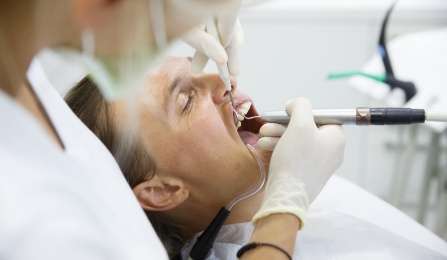Osteoporosis treatment lowers the risk of severe gum disease by nearly 50 percent in postmenopausal women

Treatment for osteoporosis may also help prevent gum disease, according to new University at Buffalo research that examined the prevalence of periodontitis in postmenopausal women.
The study revealed that women over the age of 50 treated with estrogen for osteoporosis – a condition in which the bones become weak and brittle from tissue loss – are 44 percent less likely to have severe periodontitis than women who did not receive the treatment.
The lack of estrogen, a natural consequence of menopause, places women at risk of osteoporosis as they age. To counter these effects, some women are prescribed estrogen therapy along with supplements of calcium and vitamin D.
Although previous studies have investigated the relationship between osteoporosis and tooth loss, few have examined the link between estrogen therapy and periodontitis, a disease that can ultimately lead to tooth loss and destruction of the jaw bone.
"These results help confirm the findings of previous studies that suggested that estrogen therapy to prevent osteoporosis could also play a role in the prevention of gum disease," says Frank Scannapieco, DMD, PhD, co-author on the study, and professor and chair of the Department of Oral Biology in the UB School of Dental Medicine.
"By advancing our understanding of how this treatment can impact oral health, we can better work to improve the bone health and quality of life of female patients."
The study, "Association Between Osteoporosis Treatment and Severe Periodontitis in Postmenopausal Women," was led by Johelle de S. Passos-Soares, PhD, at the Federal University of Bahia in Brazil, and published in the July issue of Vol. 24 of Menopause: The Journal of the North American Menopause Society.
The research examined nearly 500 postmenopausal women who received service at an osteoporosis diagnosis center in Brazil. Of the 356 women who were diagnosed with osteoporosis, 113 chose to receive estrogen therapy.
Each participant was over the age of 50 and postmenopausal for at least one year. They were divided into two categories: women who received estrogen therapy for at least six months and those who never received treatment. Other factors such as race, income and level of education were also recorded.
The researchers found that women receiving osteoporosis treatment had less periodontal probing depth and clinical attachment loss – the amount of space between teeth and surrounding tissue due to bone loss – and less gum bleeding than those who did not receive therapy.
The study also found that higher family income and more frequent consultations with a dentist were associated with a lower prevalence of periodontitis.
Despite the evidence of estrogen playing a significant role in maintaining healthy bones, hormone therapy also has been shown to cause adverse effects, such as increasing the risk of heart disease and breast cancer, says Scannapieco.
Future research is needed to understand if prevention and treatment of osteoporosis may also help to control periodontal disease and tooth loss.
More information: Johelle de S. Passos-Soares et al. Association between osteoporosis treatment and severe periodontitis in postmenopausal women, Menopause (2017). DOI: 10.1097/GME.0000000000000830















